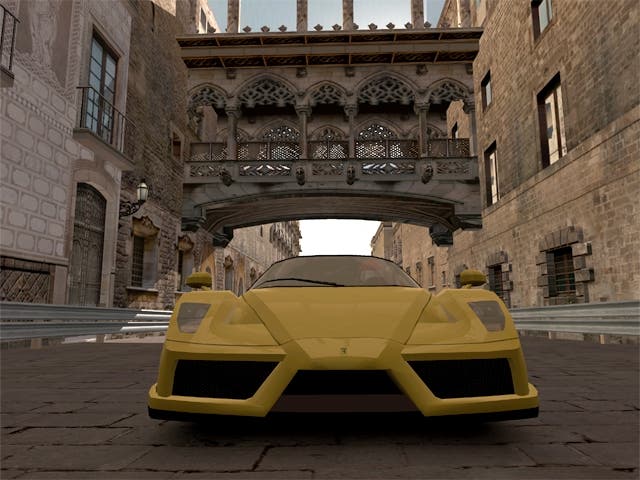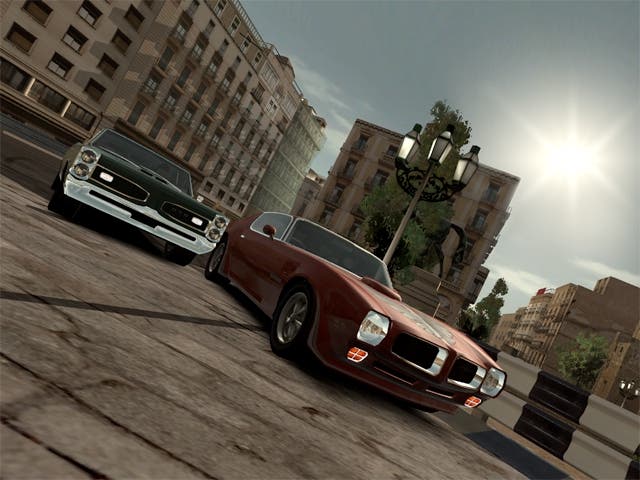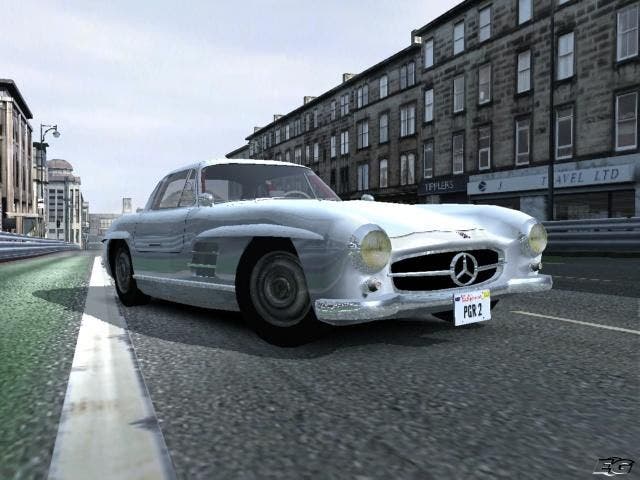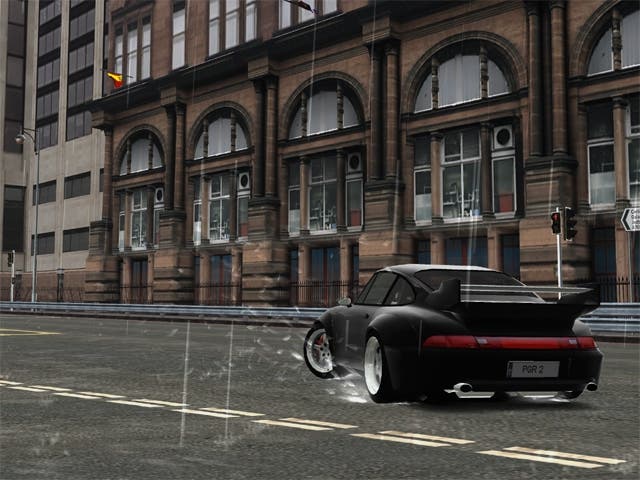Project Gotham Racing 2
The racing game of the year? Kristan journeys to Liverpool to find out.
When we first cast our eyes over PGR2 back at E3, it was obvious even at that early stage that Bizarre Creations had something very special on its hands. Given double the time to make the game, the Liverpool-based team has put the time to good use; 10 all-new cities painstakingly recreated, 103 cars, full Live play, 250 licensed music tracks, and an overhauled, fairer Kudos system. Could this be the street racing game to top them all?
Perhaps the most exciting and ambitious element of PGR2 is how seamlessly the team has integrated Live play into the proceedings. Every single race in the game, including the Time Attacks, can be raced with up to seven others across the world over Live, and the results will be logged on a constantly updated leaderboard, giving any user the chance to not only see how they rank against the world, but narrow that list down to their friends and also download anyone else's ghosts to view their performances.
A multiplayer marvel

Unlike most titles with an online multiplayer element, players' performances on Live will earn Kudos in just the same way as you would offline, meaning you can unlock all the cars without ever having to touch the single player game if you don't want to. Unlocking cars requires that you earn Kudos tokens, which are picked up once you've passed the required level of Kudos on any given track.
As before, earning Kudos is all about driving with style; drafting, endless power sliding, overtaking, jumps, two-wheelers, and keeping to the racing line - all without smacking into obstacles. But unlike the somewhat harsh system employed in the original, if you happen to clip something on your 10th combo, you won't lose the lot anymore - just your last combo - allowing the total to properly reflect your driving prowess.
Unlocking tracks, meanwhile, can also be achieved online, by beating far superior opponents. Rewards are staggered, with the positional bonus awarded at the end of the race relating to how good that achievement is compared to the opposition standard. Once you've earned your Kudos tokens you can then wander around a virtual showroom in first person view and check out all the various manufacturers' goodies muttering "one day all this will be mine" to yourself. If you've got the cash you can buy a new car there and then, or else take one out for a spin on a specially constructed test track that allows you to get a feel for it. Any car that you manage to unlock gets stored in your own garage, so you can have a quick gloat to yourself anytime you fancy.
Accessible

Difficulty wise, the game has been made both a little harder and more accessible, with the introduction of two new difficulty settings. At the novice end of the scale there's now a 'Steel' level, progressing up through Easy (Bronze), Medium (Silver), Hard (Gold) and the new Expert (Platinum) level for those who eat, sleep and doubtlessly poo Gotham.
Justifiably, the original PGR was dubbed MSR 1.5, given that it was essentially the same game that appeared on Dreamcast a year before with an extra city and a tweaked Kudos system. This time around, though, all the previous cities have been ditched in favour of 10 beautifully recreated locations chosen from an original shortlist of 60 including Hong Kong, Barcelona, Moscow, Edinburgh, Washington DC, Chicago, Florence, and Stockholm. An amazing amount of time an effort went into recreating each city, with members of the team deployed to each location armed with a 160 rolls of film to produce 5,760 pictures per city.
To get the layout as accurate as possible, the team scanned in city road maps, then procured more detailed blueprint maps from the relevant local authorities to pinpoint object location down to the individual tree, the exact building height and even the placing of lampposts and fire hydrants. Clearly the team had to use a certain amount of artistic licence to conjure each circuit, so certain sections were flattened to make way for the road, but all the key recognisable landmarks were retained.
A labour of love

According to lead city artist Derek Chapman, each city took 13-15 months to recreate, with often as many as eight artists working on one at any given time.
Chapman also revealed that each city is made up of over a million triangles and sports three times as much texture detail as the original. In the 'flesh' it's hard not to be truly blown away at all the effort that's gone into recreating some of the world's most beautiful urban environments. One of the most noticeable improvements is the dynamic lighting system employed, which improves the often gloomy appearance of the original no end. Meanwhile, surface undulation in each city is far more prevalent, giving each circuit a much more convincing feel than the ostensibly flat tracks of the original. The buildings, meanwhile, have also been given considerably more depth, with archways, windows, columns and doors being built as fully 3D structures to give a far more realistic impression as you bomb around the circuits.
In addition, an array of ambient effects such as flying birds, rollercoaster rides and swaying trees bring the cities to life, while rain and day/night variations also helping to keep things varied and convincing. One slight concern, however, was the almost marble-esque road surfaces in the wet, with a degree of reflection that looked out of kilter with the supreme sense of realism elsewhere.
Inevitably all this extra detail comes at a price, with the overall frame rate locked at 30 FPS, rather than the 60 used in the original. Lead programmer Roger Perkins argued: "We wanted to keep the visual quality. We'd rather it was running at a consistent frame rate at 30, than occasionally chugging at 60 as it did in the original. Microsoft did some research and found people didn't even notice whether the game was running at 30 or 60 FPS." And to be fair, having played the game for an hour or so, we didn't notice either.
Not perfect - yet

What we did notice, however, was some occasional lag issues when playing over Live, with opponents often jerking wildly into the distance, before appearing again virtually on top of you. Very disconcerting, and we can only hope the final tweaks and testing will iron out such quirks.
One area we're in absolutely no doubt over is the game's handling dynamics. In one particularly mind boggling display of attention to detail, the team showed how each of the 103 cars is totally unique, being comprised of differing Mass, Tyres, Friction and Suspension, although Bizarre Creations is wisely "getting the balance between realism and accessibility". Every possible stat was sourced either direct from the manufacturer, or via enthusiast magazines, but the key point is the team isn't heading down the road of simulation over what feels "right". "We want to make the cars feel as fun as possible." Amen to that.
Even the audio has had a complete overhaul, with some of the most painstaking reconstruction of engine noise we've ever heard. Every car had an eight track recording process, with microphones strategically placed to sample the various engine, exhaust, transmission and turbo sounds for your listening pleasure. The team ripped out the Xbox's audio system and wrote their own proprietary system for the game to allow them independent control over every speaker and more control over the reverb than would normally be possible. To hear it for yourself is immensely impressive.
Audio ecstasy

Switching between camera views demonstrates the point, with the emphasis of the sounds shifting realistically. Sit in bumper cam mode and you're really in the engine, but pan back to behind the car and you'll get a heavier emphasis on the exhaust, while approaching cars will have the same effect and pan past you entirely convincingly. They've even recorded ambient sounds from each city, which you'll hear as you tear up the streets. Basically it's incredible.
Music wise, Bizarre is playing its cards close to its chest regarding the line up, but is using 5.1 surround music wherever possible, or simulating quadraphonic sound otherwise. Over 250 tracks have been licensed for the game, with a GTA-style radio system allowing DJs to throw in weather reports, wish the player happy birthday, or even happy Valentine's Day if you happen to be playing it on that day. If that doesn't appeal, users can still rip their own soundtrack.
After all this information overload, we were pretty keen to actually play the game, and via a mixture of Live play with the assembled and solo play, we had a blast around the early tracks. In single player, just three cars await you in the Compact Sport range; the Mini Cooper S, Seat Leon or the VW New Beetle RSI, with the likes of the Ford Focus R1, Honda Civic Type R, Renault Clio V6, VW 32, and Lancia Delta Integrale Evo there for you to unlock.
Polished
We blasted through a few Street Races, One On Ones, as well as the obligatory Kudos tests, which we passed with flying colours, and the new Speed Camera mode which tasks you with reaching a predetermined speed once you hit the finish line. Everything felt utterly polished, with silky smooth, responsive handling, no framerate glitches, and only marred by some very occasional pop-up, which should be ironed out over the coming weeks. Predictably the damage modelling system is a tad powder puff, with the inevitable manufacturer restrictions, but there's still a few nice spidering effects when you smash up the windscreen and so on, but in the main you'll only ever see a few dents no matter how harshly you treat your car.
At this stage we're in no real position to comment fully on how PGR2 measures up as a gaming experience, but from what we now know and having had a quick blast, it's abundantly clear that it's going to be regarded as a benchmark product that will help give the Xbox another killer app. Even casual fans of driving games will get obsessed with this one, we absolutely guarantee it.

